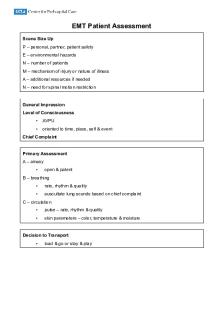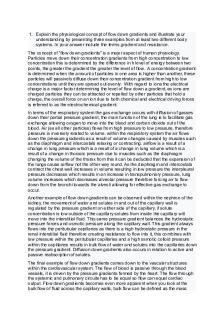Flow down gradint - Essay for final assessment PDF

| Title | Flow down gradint - Essay for final assessment |
|---|---|
| Course | Biomedical Physiology |
| Institution | Murdoch University |
| Pages | 2 |
| File Size | 61.2 KB |
| File Type | |
| Total Downloads | 91 |
| Total Views | 142 |
Summary
Essay for final assessment ...
Description
1. Explain the physiological concept of flow down gradients and illustrate your understanding by presenting three examples from at least two different body systems. In your answer include the terms gradient and resistance. The concept of “flow down gradients” is a major aspect of human physiology. Particles move down their concentration gradients from high concentration to low concentration this is determined by the difference in h level of energy between two points, the greater the gradient the greater the level of flow. A concentration gradient is determined when the amount of particles in one area is higher than another, these particles will passively diffuse down their concentration gradient from high to low concentrations until they are spread out evenly. With regard to ions the electrical charge is a major factor determining the level of flow down a gradient, as ions are charged particles they can be attracted or repelled by other particles that hold a charge, the overall force on an ion due to both chemical and electrical driving forces is referred to as the electrochemical gradient. In terms of the respiratory system the gas exchange occurs with diffusion of gasses down their partial pressure gradient, the main function of the lung is to facilitate gas exchange allowing oxygen to move into the blood and carbon dioxide out of the blood. Air (as all other particles) flows from high pressure to low pressure, therefore pressure is inversely related to volume. within the respiratory system the air flows down the pressure gradients as a result of volume changes caused by muscles such as the diaphragm and intercostals relaxing or contracting. airflow is a result of a change in lung pressure which is a result of a change in lung volume which is a result of a change in thoracic pressure due to muscles such as the diaphragm changing the volume of the thorax from this it can be deducted that the expansion of the lungs cause airflow not the other way round. As the diaphragm and intercostals contract the chest wall increases in volume resulting in low pressure the interpleural pressure decreases which results in an increase in transpulmonary pressure, lung volume increases which decreases alveolar pressure therefore forcing air to flow down from the bronchi towards the alveoli allowing for effective gas exchange to occur. Another example of flow down gradients can be observed within the nephron of the kidney, the movement of water and solutes in and out of the capillary wall is regulated by the pressure gradient on either side of the capillary, if solute concentration is low outside of the capillary solutes from inside the capillary will move into the interstitial fluid. This same pressure gradient balances the hydrostatic pressure forces and osmotic pressure along the capillary wall. This gradient always flows into the peritubular capillaries as there is a high hydrostatic pressure in the renal interstitial fluid therefore creating resistance to flow into it, this combines with low pressure within the peritubular capillaries and a high osmotic colloid pressure within the capillaries results in bulk flow of water and solutes into the capillaries down the pressure gradient. Diffusion down gradients also occurs in relation to active and passive reabsorption of solutes. The final example of flow down gradients comes down to the vascular structures within the cardiovascular system. The flow of blood is passive through the blood vessels, it is driven by the pressure gradients formed by the heart. The flow through the systemic and pulmonary circuits has to be equal so flow can equal cardiac output. Flow down gradients becomes even more apparent when you look at the bulk flow of fluid across the capillary walls, bulk flow can be defined as the mass
movement of H2O and solutes is response to pressure gradients. The flow of fluid across capillaries is passive and is a result of starling forces referred to as hydrostatic pressure which is the force created due to pressure on the internal surface of the vessel walls and osmotic pressure which is the pressure exerted onto the membrane by the movement of water ions down he concentration gradient. As it has been demonstrated by the select few examples expanded upon above the concept of flow down gradients is crucial in caring out basic bodily functions and maintaining overall homeostasis. Particles such as ions, solutes, air and even blood will always flow from high concentration to low concentration moving down their concentration gradients in an effort to achieve equilibrium....
Similar Free PDFs

Final Assessment Essay VRTS111
- 2 Pages

Patient Assessment Flow Chart
- 2 Pages

Final Essay for subject
- 4 Pages

Final exam for pyschological assessment
- 121 Pages

Put that phone down! Essay
- 6 Pages

Essay Assessment
- 11 Pages

Final Essay for English 1301
- 4 Pages

Flow-Chart-Final
- 4 Pages

Final Assessment
- 8 Pages

Flow Diagram for 588GA
- 2 Pages

Law4074 essay assessment
- 14 Pages
Popular Institutions
- Tinajero National High School - Annex
- Politeknik Caltex Riau
- Yokohama City University
- SGT University
- University of Al-Qadisiyah
- Divine Word College of Vigan
- Techniek College Rotterdam
- Universidade de Santiago
- Universiti Teknologi MARA Cawangan Johor Kampus Pasir Gudang
- Poltekkes Kemenkes Yogyakarta
- Baguio City National High School
- Colegio san marcos
- preparatoria uno
- Centro de Bachillerato Tecnológico Industrial y de Servicios No. 107
- Dalian Maritime University
- Quang Trung Secondary School
- Colegio Tecnológico en Informática
- Corporación Regional de Educación Superior
- Grupo CEDVA
- Dar Al Uloom University
- Centro de Estudios Preuniversitarios de la Universidad Nacional de Ingeniería
- 上智大学
- Aakash International School, Nuna Majara
- San Felipe Neri Catholic School
- Kang Chiao International School - New Taipei City
- Misamis Occidental National High School
- Institución Educativa Escuela Normal Juan Ladrilleros
- Kolehiyo ng Pantukan
- Batanes State College
- Instituto Continental
- Sekolah Menengah Kejuruan Kesehatan Kaltara (Tarakan)
- Colegio de La Inmaculada Concepcion - Cebu




